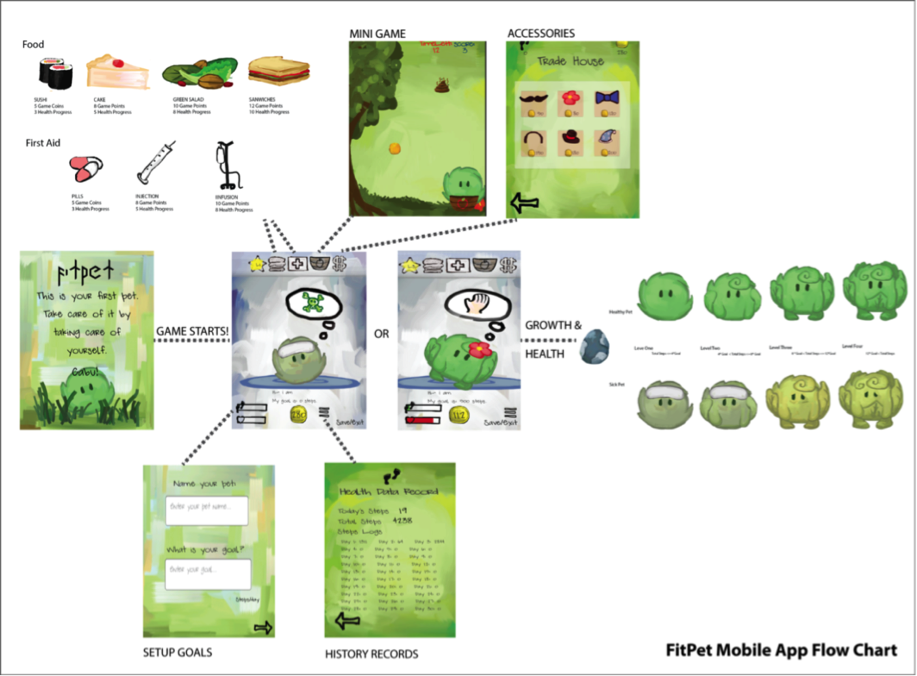In light of the criticism and controversy surrounding gamification and a relative lack of rigorous studies evaluating its effectiveness, in this paper, Xin Tong developed a research prototype based on a game idea – FitPet. Next, she set out to evaluate the effectiveness of the FitPet approach and compared it with two gamification methods – goal-setting and social interaction – in a six-week field study. Xin Tong explored how the incentives and their sub-components worked as motivators for promoting increased physical activity amongst participants.
Persuasive health systems such as wearable trackers and mobile applications can facilitate self-reflection on one’s physical activity. The gamification approach incorporates game design elements with persuasive systems to encourage more physical activity. However, some investigations have shown that using gamification to promote physical activity could have contradictory effects. To explore the conflicted findings in more detail, we designed and studied FitPet – an interactive virtual pet-keeping mobile game focused on encouraging physical activity.
In a six-week field study, the effectiveness of FitPet was evaluated and compared with two other gamification strategies, the goal-setting strategy and the use of social communities. Below figure demonstrates how the virtual creature will be changed according to the players’ physical activity data.
Findings are that the social interaction strategy was the most effective intervention among these three. Contrary to prior research, goal-setting was not found to be as effective at providing motivation compared to social interaction.
(a) For the goal-setting approach, though participants already knew their baseline level before the intervention phase, most people still did not know how they could set an appropriate personal goal and what their goals should be in their context.
(b) For the two types of social interventions tested in the social group, the Website Community was considered to be a passive way of communication and was not active enough for people to engage, while participants experienced active participation, competition, and collaboration in the Mobile Challenge group. The social communication strategy in the Challenge Group offered more synchronous feedback, communication, and collaboration.
(c) The FitPet mobile game was not motivating enough to promote changes, which was not what we had expected in the design phase of this project. Participants liked the main design idea. However, they the game did not provide constant awareness or feedback as a wearable wristband, therefore, people had less emotional investment and attention for the virtual pet than a Tamagotchi.
The lessons learned from this research can inform the design of applications for promoting physical activity or well-being behavior changes. From the analysis, we found that the social aspects are evaluated as an effective strategy if used correctly and under certain circumstances. For example, some social aspects can involve participants in an active and engaging way, such as socializing and having fun with each other. Conversely, the passive communication afforded in the Website Community has not proven very effective in promoting physical activity. Moreover, besides social competition, opportunities for positive collaborations should be considered as an important type of social interaction when designing for gamification. Specifically, social components should be implemented in a FitPet-like game approach, and its effectiveness should be investigated.
Furthermore, since FitPet-like games hold the potential to engage people and we see people’s enthusiasms about making achievement in a larger context than their personal goals. More mechanics and dynamics are needed to enhance the level of players’ awareness and engagement. Attending to these issues will help in the ways in which ubiquitous and persuasive technologies can be used to encourage physical activity and promote healthy behavior changes. The reflections of this research and critiques of others in the same fields helped us understand: to be effective and efficient, the context where gamified approaches are used matters.
- Tong, X., Gromala, D., Shaw, C. D., & Neustaedter, C. (2016). “Examining the Efficiency of Gamification Incentives for Encouraging Physical Activity–Social Collaborations or Interactive Mobile Games”. PervasiveHealth2016, 1-10.
- Tong, X., Gromala, D., Shaw, C., & Jin, W. (2015, October). “Encouraging physical activity with a game-based mobile application: FitPet”. In 2015 IEEE Games Entertainment Media Conference (GEM) (pp. 1-2). IEEE.

